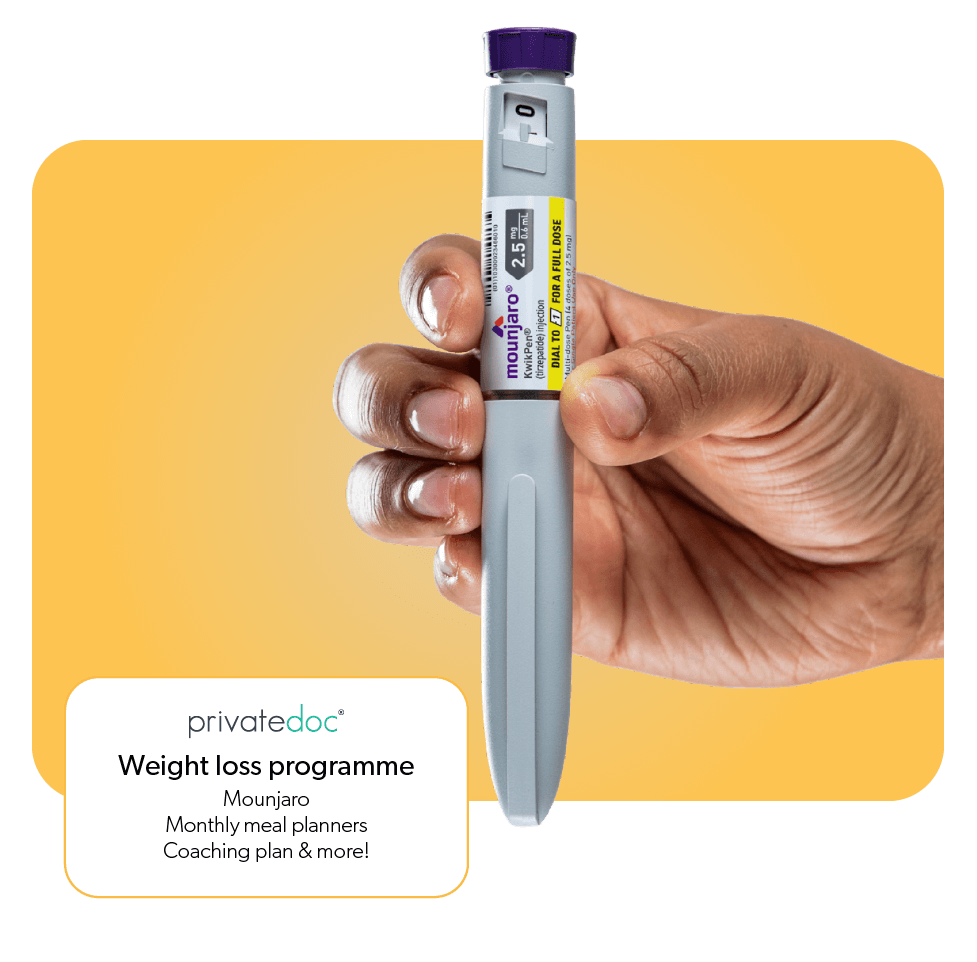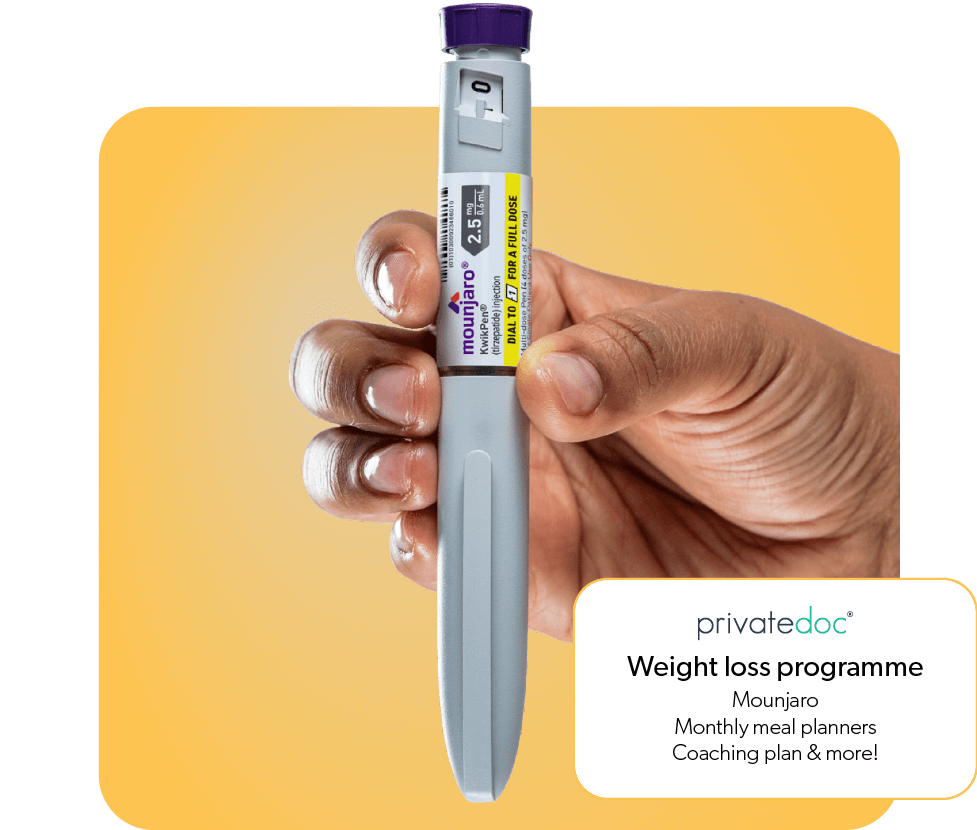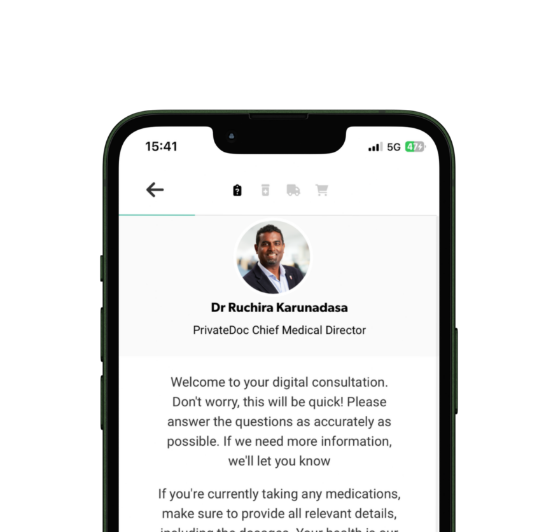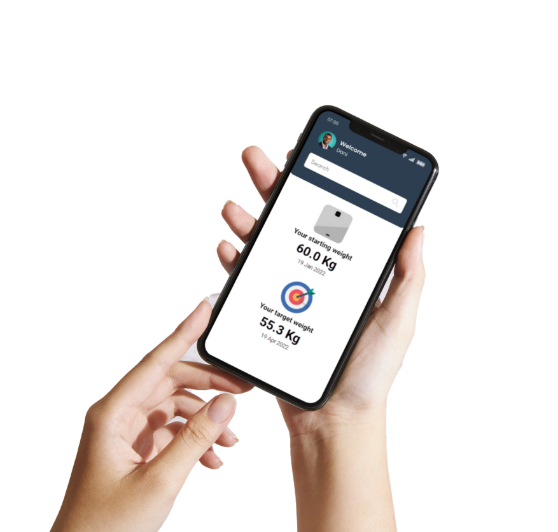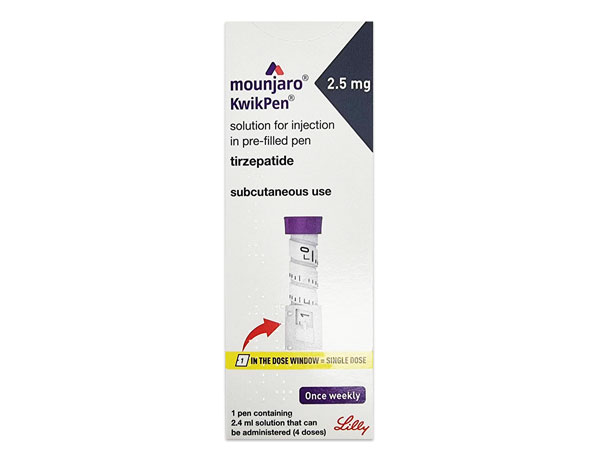Mounjaro
Mounjaro (Tirzepatide) - the new weight loss medication in the UK.
Targeting both GLP-1 and GIP receptors to help curb your appetite, make you feel fuller and improve the body's usage of fat stores.
Part of our weight loss treatment planHow does Mounjaro work?

CHIEF MEDICAL OFFICER
Dr Ruchira Karunadasa
MB BS - GP
Mounjaro promotes weight loss by decreasing appetite, as well as directly impacting the pathways that lead to fat loss. Unlike other GLP-1 medications, Mounjaro activates both GLP-1 and GIP receptors, promoting the utilisation of stored fat for energy in addition to curbing appetite.

Decrease food intake

Enhances insulin secretion

Improves insulin sensitivity
Additional actions include delayed gastric emptying* and reduced glucagon levels
*This effect diminishes over time.
How the PrivateDoc
Weight Loss Programme works
* Your eligibility for our treatment plan will be assessed by a clinical professional following a consultation.
What is the science behind Mounjaro?
Mounjaro employs a multifaceted approach to enhance weight management. It facilitates the release of insulin in response to elevated blood sugar levels, aids in the removal of excess sugar from the bloodstream, curtails the liver's production and release of excessive sugar, reduces overall food intake, and moderates the speed at which food exits the stomach. Notably, the latter effect gradually diminishes over time.
Mounjaro Weight Loss results.
In recent studies (SURMOUNT 1), individuals taking Mounjaro experienced significant weight loss compared with the placebo group.
At 72 weeks the average weight loss was 13.8kg on the 5-mg dose, 19.8kg on the 10-mg dose, and 21.2kg on the 15-mg dose. This equated to an average baseline reduction of 16.0% on the 5mg-dose, 21.4% on the 10mg-dose and 22.5% on the 15mg-dose.
How much does Mounjaro cost?
Is Mounjaro suitable for me?
When you join PrivateDoc we will assess your individual circumstances to see if we think Mounjaro will help with your weight management.
Mounjaro (pronounced mown-JAHR-OH) is an injectable medication designed for adults with type 2 diabetes. It is used in conjunction with a balanced diet and regular exercise to enhance blood sugar (glucose) management. PrivateDoc will evaluate your medical history, current health status, and other factors such as medications you may be taking, to determine if Mounjaro is suitable for you.
How do I use Mounjaro?
Take Mounjaro once a week, selecting a day that suits your schedule. Administer Mounjaro at any time on your chosen day. However, if you wish to change your dosing day, ensure a minimum of 3 days (72 hours) between doses. If a dose is missed, take it within 4 days (96 hours) after the missed dose. If more than 4 days have elapsed, skip the missed dose and resume on your regular day. Avoid taking two doses within 3 days of each other. Consider setting a reminder on your phone for your Mounjaro day, and if you change the day, update your reminder accordingly.
How do I administer my Mounjaro injection?
Administer Mounjaro by subcutaneous injection, either in your stomach (abdomen), thigh, or upper arm, once a week at any time of the day. Change your injection site each week. You may use the same area of your body, but be sure to choose a different injection site in that area. Always use a new pen needle for each injection to help prevent infections and blocked needles. In case of an overdose, promptly contact your healthcare provider or seek medical advice.

What are the possible side effects of taking Mounjaro?
As is the case with any medication, Mounjaro can cause some patients to experience side effects. Some of these are listed below but for the full list please click here for a copy of the patient information leaflet
Very common and common side effects:
- Nausea and/or vomiting
- Gastrointestinal side effects – e.g. diarrhoea, constipation, bloating, indigestion, burping, gas, reflux (heartburn)
- Symptoms of low blood sugar levels (hypoglycaemia) – these can include but are not limited to sweating, dizziness, feeling light headed, headache, feeling drowsy, feeling weak, confusion, mood changes such as feeling irritable
- Allergic reactions (hypersisitivity) – e.g. rash, itching, eczema
- Abdominal pain
- Hair loss
- Tiredness
- Fast pulse
- Injection site reactions – e.g. itching, redness, swelling
- Increased levels of pancreatic enzymes – e.g. lipase and amylase
Uncommon side effects:
- Gallstones
- Gallbladder infection
- Injection site pain
- Increased blood levels of calcitonin
Serious side effects:
- Inflammed pancreas (acute pancreatitis)
- Severe allergic reactions (Anaphylaxis)
How do I store Mounjaro?
Unused pens:
Store unused pens in the refrigerator between 2°C to 8°C
Unused pens may be used until the expiration date printed on the label if the pen has been kept in the refrigerator
Do not freeze.
Used pens:
You may store your pen at room temperature up to 30°C, or in the refrigerator, after you inject the first dose. All pens following first use must be discarded after 30 days.
Keep away from heat.
What if im going on a holiday?
Mounjaro remains viable unrefrigerated for a duration of up to 30 days, provided the temperature does not exceed 86°F (30°C). To safeguard the pen from light exposure, keep it in its original carton.
Keep the container out of the reach of children. Do not recycle your sharps container, follow your community guidelines for the right way to dispose of your sharps disposal container.
How do I dispose of your my Mounjaro pens
Dispose of the pen 30 days after first use or after receiving 4 weekly doses, even if it looks like there may be some liquid left in the device. To dispose of safely, place the pen needles in an approved sharps disposal container immediately after use. If you lack an approved sharps container, use a sturdy household container made of heavy-duty plastic with a puncture-resistant lid. Ensure it is upright, stable, leak-resistant, and appropriately labelled to indicate hazardous waste.
Keep the container out of children's reach, and refrain from recycling the sharps container. Instead, adhere to community guidelines for the proper disposal of sharps containers. The pen device can be disposed of via normal household waste or by returning to your nearest pharmacy if there is still medication inside.
What are the dose options for Mounjaro
The starting dose of Mounjaro is 2.5mg once a week for 4 weeks. After 4 weeks your doctor will increase your dose to 5mg once a week. Let your doctor know how you’re doing on with the 2.5mg and 5mg doses during your checkup. Your doctor will decide if additional dose increases are needed. Do not change your dose unless your doctor has told you to. The dose options available for Mounjaro are 2.5mg, 5mg, 7.5mg, 10mg, 12.5mg and 15mg. You can stop increasing when you reach a dose you feel in working for you. For Mounjaro, 5mg, 10mg and 15mg are considered maintenance doses.
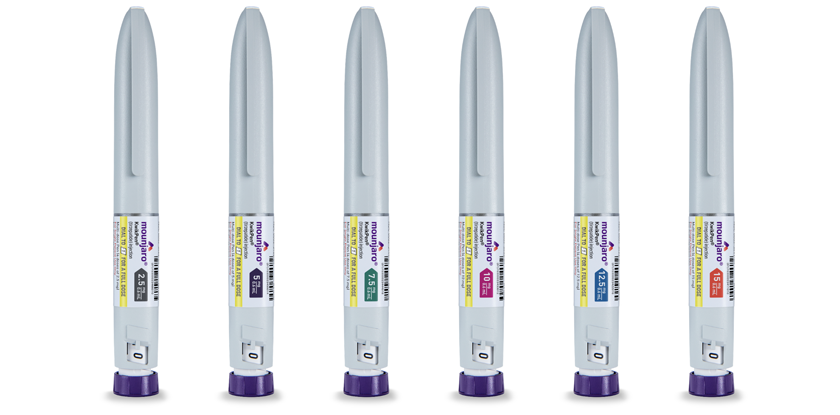
What diet should I follow on Mounjaro?
Whilst on any of our prescription weight loss treatments we recommend following a calorie controlled diet to support your goals. As this can be a confusing area with lots of mixed messaging, we partnered with leading nutritionist Glen Matten to bring to you our very own PrivateDoc diet guide. You can find out more here: PrivateDoc Diet Guide

Where to buy Mounjaro online?
While many online retailers claim to supply genuine medicines, they may be unregulated, provided without a genuine doctor consultation and potentially very dangerous. You can rest assured, PrivateDoc is a fully registered digital health service. We have UK registered doctors that review and assess every consultation. All the medicines we supply are 100% genuine and fully regulated by the Medicines and Healthcare products Regulatory Agency (MHRA).
Mounjaro vs Wegovy, Mysimba & Saxenda
Mounjaro employs a multifaceted approach to enhance weight management. It facilitates the release of insulin in response to elevated blood sugar levels, aids in the removal of excess sugar from the bloodstream, curtails the liver's production and release of excessive sugar, reduces overall food intake, and moderates the speed at which food exits the stomach. Notably, the latter effect gradually diminishes over time. Read more on the differences of medications here
The Experts
Your health is in safe hands! Our clinical team are with you every step of the way.
FAQs
Discover the answer to some common questions around weight loss treatment.
-
Are weight loss pens suitable for me?
Weight loss pens can only be used as a weight-loss treatment if you have previously tried and failed to lose weight through diet and exercise alone.
You can expect to lose a minimum of 5% of your initial body weight after completing 12 weeks of treatment. If you have not lost 5% of your initial body weight after 12 weeks, then treatment should be discontinued at this stage.
-
How do I administer weight loss injections
Weight loss injections are self-administered subcutaneous injections that you inject under your skin. The best sites for injecting are the front of your waist (abdomen), the front of your thigh or the upper arm. You must take extra care not to inject into a vein or muscle.
If you accidentally use more than you should, you must talk to a doctor or go to a hospital straight away. You may experience nausea or vomiting and may require medical treatment.
If you forget a dose, you can inject it as soon as you remember, as long as it is within 12 hours from when you usually take your dose. However, if more than 12 hours have passed since you should have used it, miss the dose and inject your next dose the following day at the usual time. Never use a double dose or increase the dose on the following day to make up for the missed dose. If there has been more than 72 hours (three days) between doses, you should return to the 0.6mg starting dose and work through the doses as you did when you first started treatment.
-
What are the possible side effects of taking weight loss injections
As with all medication, weight loss pens can be associated with unwanted side effects. Although usually mild, some can be more severe, which may result in your treatment being stopped. You should always read the patient information leaflet fully before you begin treatment.
When you first start your treatment, you may experience some stomach upset, such as vomiting or diarrhoea, and may also lose some bodily fluids. Therefore, it is important to drink plenty of fluids to keep yourself hydrated. Most mild side effects will settle once your body gets used to the new medication. However, if any side effect persists, stop the treatment and talk to a doctor.
Sometimes side effects can be very serious, such as severe allergic reactions. If you get any symptoms, such as problems breathing, swelling of your face or throat, or a fast heartbeat, you must get medical help immediately.
Rarely there have been cases reported of inflammation of the pancreas (pancreatitis). Pancreatitis is a serious, potentially life-threatening, medical condition. If you experience any of the following side effects stop taking it immediately and get medical help: severe and persistent pain in the abdomen (stomach area) which might reach through to your back with nausea or vomiting.
Side effects can include, but are not limited to:
Very common side effects (may affect more than 1 user in 10 users)
- Nausea vomiting (settles after your body adjusts to treatment)
- Diarrhoea or constipation (settles after your body adjusts to treatment)
Common side effects (may affect up to 1 to 10 users)
- Low blood sugar. The warning signs of low blood sugar may come on suddenly and can include: cold sweat, cool pale skin, headache, fast heartbeat, feeling sick, feeling very hungry, changes in vision, feeling sleepy, feeling weak, being nervous, being anxious, confusion, difficulty concentrating and shaking (tremor). Your doctor will tell you how to treat low blood sugar and what to do if you notice these warning signs
- Problems affecting the stomach and intestines, such as indigestion (dyspepsia), inflammation in the lining of the stomach (gastritis), stomach discomfort, upper stomach pain, heartburn, feeling bloated, wind (flatulence), belching and dry mouth
- Difficulty sleeping (insomnia). This usually occurs in the first 3 months of treatment
- Local reactions around the injection site, such as bruising, pain, irritation, itching and rash
- Feeling weak or tired
- Changed sense of taste
- Dizziness
- Gallstones
- Increase of pancreatic enzymes, such as lipase amylase
Uncommon side effects (may affect up to 1 in 100 people)
- Dehydration – more likely to occur at the start of treatment and may be due to being sick, having diarrhoea or nausea making you drink & eat less
- Thyroid reactions such as goitres or nodules
- Pancreatitis
- Allergic reactions such as skin rash
- Generally feeling unwell
- Faster pulse rate
- Delay in the emptying of the stomach
- Inflamed gall bladder
Rare side effects (may affect up to 1 in 1,000 people)
- Reduced kidney function
- Acute kidney failure. Signs may include reduction in urine volume, metallic taste in mouth & easily bruising
The information we provide to our patients is based on the information provided by the manufacturer of the medication. This information is based on the latest and best, current evidence.
-
What diet should I follow while using weight loss injections
Whilst on any of our prescription weight loss treatments we recommend following a calorie controlled diet to support your goals. As this can be a confusing area with lots of mixed messaging, we partnered with leading nutritionist Glen Matten to bring to you our very own PrivateDoc diet guide.




